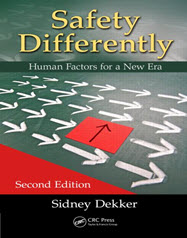 Book reviews
Book reviews-
Safety Differently: Human Factors for a New Era
Publisher
: CRC Press, Boca Raton
Title
: Safety Differently: Human Factors for a New Era
Author Sidney Dekker Year of Publication
: 2015
Pages
: 296
ISBN
: 978-1-4822-4299-0
Reviewer
: Krishna B. Misra
Status
: Review Complete
The book comprises 8 chapters that are preceded by a Preface, Acknowledgements and About the Author and are followed by References and Index.
Chapter 1
Making the World a Better Place
33 Pages
Chapter 2
It Was Human Error
43Pages
Chapter 3
People as a Problem to Control
36 Pages
Chapter 4
Danger of Losing Situation Awareness
35 Pages
Chapter 5
Accidents
21 Pages
Chapter 6
Methods and Models
34 Pages
Chapter 7
New Technology and Automation
28 Pages
Chapter 8
New Era in Safety
38 Pages
References
12 Pages
Index
12 Pages
The author of this book is a professor at Griffith University in Brisbane, Australia and runs the Safety Science Innovation Laboratory. He has authored many best-selling books on human factors and safety. This book, in second edition, is a complete update of Ten Questions About Human Error: A New View of Human Factors and
 System Safety. He works as a part-time pilot of Boeing 737NG and therefore it is not surprising that many examples and case studies cited on safety problems in the book are from aviation area. The book includes discussion of the latest human factors/ergonomics research in safety problems and provides case studies on human factors and safety.
System Safety. He works as a part-time pilot of Boeing 737NG and therefore it is not surprising that many examples and case studies cited on safety problems in the book are from aviation area. The book includes discussion of the latest human factors/ergonomics research in safety problems and provides case studies on human factors and safety.This is an interesting book and therefore the reviewer would like to recommend that it should be read by anyone who is keen to understand whether the subject of safety should be human-centric or not The author believes that for the first half of the 20th century, the safety problems were addressed by controlling the human factors. A new paradigm in human factors has sprouted in which the world in which people work is not fixed. Instead, the technology needs to be adopted to fit the strengths and limitations of the people. Therefore the safety problems were addressed by controlling the technology, the environment and the system. People are not the initiators of a failure but recipient of it. In so–called “Swiss Cheese” image of a system the outcome failure is the result of many smaller prior failures in organizational and administrative layers upstream and these failures are related to procedures, design, supervision and management and in order to fix these failures there to prevent outcome failures.
Departing from modernist safety concept where cause-effect relationships are linear, to new era of safety, where cause-effect relationships are complex and non-linear, we need to transit from seeing people as a problem to control to seeing people as a solution to harness. We need to transit from seeing safety as a bureaucratic accountability to seeing it as ethical responsibility. We need to transit from seeing safety as an absence of negative to seeing it as the positive capacity to make things go right.
Resilience considers safety as a presence of capacities, capabilities and competencies to make things go right. Safety no longer it should be seen as absence of negatives such as errors, violations or incidences. Resilience engineering provides a new framework to understand people as a solution to harness. High performance teams and resilient organizations are those who develop and harness people’s competencies and capabilities. While robust systems are effective in meeting predicted threats and are capable of maintaining process integrity within the design, training and procedural parameters, while the resilient systems are effective in meeting threats that represent infinite reconfigurations and are capable of maintaining process integrity even outside the design base, training or procedural provisions.
This book must be read by all engineers who are concerned with the safety of engineering systems.
This review has been published in Vol. 11, No. 6, November 2015 issue of the IJPE

